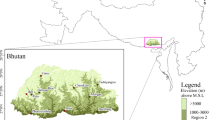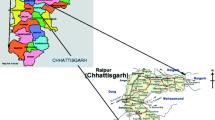Abstract
The article provides a long-term trend analysis of the Kesinga catchment daily gridded rainfall at a (0.25° × 0.25°) high spatial resolution from 1901 to 2020 (120 years). The trend in seasonal and annual rainfall was detected using rank-based nonparametric statistical tests, namely Spearman’s rho and Mann-Kendall test, which are used for detecting monotonic trends in time series data at the 5% significant level, smoothing curve, Sen’s slope test, and a plot of innovative trend analysis. The results showed that statistically significant trends had a pattern with both positive (increasing) and negative (decreasing) trends, with positive and negative trends evident in the winter and negative trends shown in the monsoon, PREMON, and annual seasons. The middle of the study area revealed the highest negative trend, and the lower Kesinga catchment showed the lowest negative annual rainfall trend. In the entire Kesinga catchment, the seasonal data and annual rainfall both showed statistically significant and non-significant patterns. Consistently, the MK and SR tests were both conducted at the validated significance level. In various contexts, the statistically significant massive trend that has occurred was negative (70%). If the current pattern continues in the future, there will be a scarcity of water and more strain on the control of water resources at the given grids in corresponding temporal scales.







Similar content being viewed by others
Data Availability
The data and materials are clarified in the material and methods section of the manuscript. The data will be made available on reasonable request.
Data Source: https://www.imdpune.gov.in/Clim_Pred_LRF_New/Grided_Data_Download.html.
References
Abeysingha, N. S., Singh, M., Sehgal, V. K., Khanna, M., & Pathak, H. (2014). Analysis of rainfall and temperature trends in Gomti river basin. Journal of Agricultural Physics, 14(1), 56–66.
Ali, M. M. (2018). Impact of climate change and natural catastrophe on the occupational changes in the coastal areas of Bangladesh: An empirical study. Environmental Economics, 9(1), 22–37.
Basistha, A., Arya, D.S., & Goel, N.K. (2009). Analysis of historical changes in rainfall in the Indian Himalayas. International Journal of Climatology, 29(4), 555–572.
Burn, D.H., & Elnur, M. (2002). Detection of hydrological Trends and variability. Journal of Hydrology, 255, 107–122.
Dahmen, E. R., & Hall, M. J. (1990). Screening of hydrology data: Test for stationarity and relative consistency. Dissertation, ILRI, Wageningen, Netherlands Publication #49.
Deng, Y., Wang, X., Wang, K., Ciais, P., Tang, S., Jin, L., Li, L., & Piao, S. (2021). Responses of vegetation greenness and carbon cycle to extreme droughts in China. Agricultural and Forest Meteorology, 298–299, 108307.
Dioha, M. O., & Kumar, A. (2020). Exploring greenhouse gas mitigation strategies for agriculture in Africa: The case of Nigeria. Ambio. https://doi.org/10.1007/s13280-019-01293-9
Dubey, S. K., Tripathi, S. K., & Pranuthi, G. (2012). Relationship between NDVI and rainfall relationship over India. International Journal of Water Resources and Environmental Sciences, 1(4), 102–108.
Duhan, D., Pandey, A., & Srivastava, P. (2018). Rainfall variability and its association with El Niño Southern Oscillation in Tons River Basin India. Meteorology and Atmospheric Physics, 130(4), 405–425.
Farhana, S., & Rahman, M. M. (2011). Characterizing rainfall trend in Bangladesh by temporal statistics analysis. In Noor, Amin Bhuiyan Chowdhury and Kakoli (eds) Proceeding of the 4th annual paper meet and 1st civil engineering congress, Dhaka, Bangladesh.
Fulekar, M. H., & Kale, R. K. (2010). Impact of climate change: Indian scenario. University News, 48(24), 1–23.
Hu, Z. Z., Yand, S., & Wu, R. (2003). Long-term climate variation in China and global warming signals. Journal of Geophysical Research, 108, D19.
Indian Meteorological Department. (2021). Free download yearly gridded data: http://www.imd.pune.gov.in. Accessed 5 Mar
IPCC. (2014). Climate change—A synthesis report of the IPCC. Technical Report, Intergovernmental Panel on Climate Change
Kahya, E., & Kalayci, S. (2004). Trend analysis of streamflow in Turkey. Journal of Hydrology, 289, 128–144.
Kale, V. S. (2002). Fluvial geomorphology of Indian rivers: An overview. Progress in Physical Geography, 26(3), 400–433.
Kampata, J. M., Parida, B. P., & Moalafhi, D. B. (2008). Trend analysis of rainfall in the headstreams of the Zambezi River Basin in Zambia. Physics and Chemistry of Earth, 33, 621–625.
Kendall, M. G. (1975). Rank correlation methods. Griffin.
Kharake, A., Pathare, J., & Deshmukh, P. (2021). Spatio-temporal variability of intra-monsoonal rainfall in Pravara-Mula River Basin India. Arabian Journal of Geosciences, 14, 890.
Kothawale, D. R., & Kumar, K. R. (2005). The recent change in surface temperature trends over India. Geophysical Research Letter, 32, L1814.
Kudnar, N. S., Diwate, P., Mishra, V. N., Srivastava, P. K., Akshay, K., & Pandey, M. (2022). Spatio-temporal variability and trend analysis of rainfall in Wainganga river basin, Central India, and forecasting using state-space models. Theoretical and Applied Climatology, 150, 469–488.
Kundu, S., Khare, D., Mondal, A., & Mishra, P. K. (2015). Analysis of spatial and temporal variation in rainfall trend of Madhya Pradesh, India (1901–2011). Environmental Earth Sciences, 73(12), 8197–8216.
Kundzewics, Z.W., & Robson, M. (2000). Precipitation extremes in the changing climate of Europe. Climate Research, 31(1), 51–58.
Lehmann, E. L. (1995). Non-parametric, statistical methods based on ranks. Holden-Day.
Li, L. Z., Xu, Z. X., Li, J. Y., & Li, Z. J. (2008). Shift rend and step changes for runoff time series in the Shiyang River Basin, Northwest China. Hydrology Processes, 22(23), 4639–4646.
Liu, Y. F., Liu, Y., Shi, Z. H., López Vicente, M., & Wu, G. L. (2020). Effectiveness of re-vegetated forest and grassland on soil erosion control in the semi-arid Loess Plateau. CATENA, 195, 104787.
Longobardi, A., & Villani, P. (2010). Trend analysis of annual and seasonal rainfall time series in the Mediterranean area. International Journal of Climatology, 10, 1538–1546.
Mann, H. B. (1945). Nonparametric tests against trend. Econometrica, 13, 245–259.
Meehl. (2000). Trend in extreme weather and climate events: Issues related to modeling extremes in projections of future climate change. Bulletin American Meteorological Society, 81(3), 427–436.
Mohammad, A. R., Lou, Y., & Nahid, S. (2017). Analysis and prediction of rainfall trends over Bangladesh using Mann–Kendall, Spearman’s rho tests and ARIMA model. Meteorology and Atmosphere Physics, 129, 4.
Oguntunde, P. G., Lischeid, G., Abiodun, B. J., & Dietrich, O. (2014). Analysis of spatial and temporal patterns in onset, cessation and length of growing season in Nigeria. Agricultural and forest meteorology, 194, 77–87.
Panda, R. K., & Gurjeet, S. (2016). Analysis of trend and variability of rainfall in the mid-Mahanadi River Basin of Eastern India. International Journal of Environmental, Chemical, Ecological, Geological and Geophysical Engineering, 10, 6.
Ren, Y., Zhang, Y., Li, B., Fu, J., & Li, Z. (2022). Projecting extreme climate events in China’s Loess Plateau: Multiple RCMs and emission scenarios corrected by a trend-preserving method. Theoretical and Applied Climatology. https://doi.org/10.1007/s00704-022-04254-7
Rimi, R. H., Rahman, S. H., Karmakar, S., & Hussain, S. G. (2014). Trend analysis of climate change and investigation on its probable impacts on rice production at Satkhira, Bangladesh. Pakistan Journal of Meteorology, 6(11), 37–50.
Saadi, Z., Shahid, S., Ismail, T., Chung, E. S., & Wang, X. J. (2019). World Meteorological Organization 2018 Guide to climatological practices, second edition. Atmospheric Physics, 131, 263–277.
Samanth, A., Rakesh, V., Purwar, S., Gavaskar, S. M., Pai, J. B., & Mohapatra, G. N. (2022). Analysis of spatio-temporal variability in observed rainfall over Karnataka using different data analytical techniques. Journal of Earth System Science, 131, 66.
Saveliava, N. I., Semiltov, I. P., Vasilevskaya, L. N., & Pugach, S. P. (2000). A climate shift in seasonal values of meteorological and hydrological parameters for Northeastern Asia. Oceanography, 47(2–4), 279–297.
Sen, P. K. (1968). Estimate of the regression coefficient based on Kendall’s tau. Journal of the American Statistical Association, 63(324), 1379–1389.
Shi, Y. F., Shen, Y. P., & Hu, R. J. (2002). Preliminary study on signal, impact and foreground of climatic shift from warm-dry to warm humid in Northwest China. Journal of Glaciology and Geocryology, 24, 219–226.
Shadmani, M., Marofi, S., & Roknian, M. (2012). Trend analysis reference evapotranspiration using Mann–Kendall and Spearman’s rho tests in arid region of Iran. Water Resources Management, 26(1), 211–224.
Sharma, S., & Saha, A. K. (2017). Statistical analysis of rainfall trends over Damodar River basin India. Arabian Journal of Geosciences, 10(15), 1–12.
Sneyers, R. (1990). On the statistical analysis of series of observations. World Meteorological Organization, Technical Note 143, WMO: 415.
Sonali & Nagesh Kumar. (2013). Review of trend detection methods and their application to detect temperature changes in India. Journal of Hydrology, 476(7), 212–227.
Turner, A. G., & Annamalai, H. (2012). Climate change and the South Asian summer monsoon. Nature Climate Change, 2(8), 587–595.
Wang, Q. X., Fan, X. H., Qin, Z. D., & Wang, M. B. (2012). Change trends of temperature and precipitation in the Plateau Region of China, 1961–2020. Global and Planetary Change, 92–93, 138–147.
Woolf, A., Haines, K., & Liu, C. (2003). A web service model for climate data access on the grid. Journal of High-Performance Computing Applications, 17(3), 281–295.
World Meteorological Organizatio (1990). 3, 2.
Yaming, Z., Jun, W., & Xinhua, W. (2011). Study on the change trend of precipitation and temperature in Kunming city based on Mann–Kendall analysis. Future Computer, Communication, Control and Automation, 119, 505–513.
Yang, Z. F., Yan, Y., & Liu, Q. (2012). The relationship of streamflow precipitation temperature in the Yellow River Basin of China during 1961–2000. Procedia Environmental Sciences, 13, 2336–2345.
Yue, S., Pilon, P., & Cavadias, G. (2002). Power of the Mann–Kendall and Spearman’s rho tests for detecting monotonic trends in hydrological series. Journal of Hydrology, 259(1–4), 254–271.
Zhang, J., Gao, G., Fu, B., Wang, C., Gupta, H. V., Zhang, X., & Li, R. (2020). A universal multifractal approach to assessment of spatiotemporal extreme precipitation over the Loess Plateau of China. Hydrology and Earth System Sciences, 24(2), 809–826.
Funding
No funding was received during the preparation of this research manuscript.
Author information
Authors and Affiliations
Contributions
PCV conceived the idea, collected and analysed the data, and led the manuscript writing. BCS and Dwarikamohan Das contributed to the development of ideas and were involved in manuscript corrections. All authors read and approved the final manuscript.
Corresponding author
Ethics declarations
Conflict of Interest
The authors declare no competing interests.
Ethics Approval
Not applicable.
Consent for Publication
Not applicable.
Additional information
Publisher's Note
Springer Nature remains neutral with regard to jurisdictional claims in published maps and institutional affiliations.
Rights and permissions
Springer Nature or its licensor (e.g. a society or other partner) holds exclusive rights to this article under a publishing agreement with the author(s) or other rightsholder(s); author self-archiving of the accepted manuscript version of this article is solely governed by the terms of such publishing agreement and applicable law.
About this article
Cite this article
Vani, P.C., Sahoo, B.C., Paul, J.C. et al. Trend Analysis in Gridded Rainfall Data Using Mann-Kendall and Spearman’s Rho Tests in Kesinga Catchment of Mahanadi River Basin, India. Pure Appl. Geophys. 180, 4339–4353 (2023). https://doi.org/10.1007/s00024-023-03379-8
Received:
Revised:
Accepted:
Published:
Issue Date:
DOI: https://doi.org/10.1007/s00024-023-03379-8




